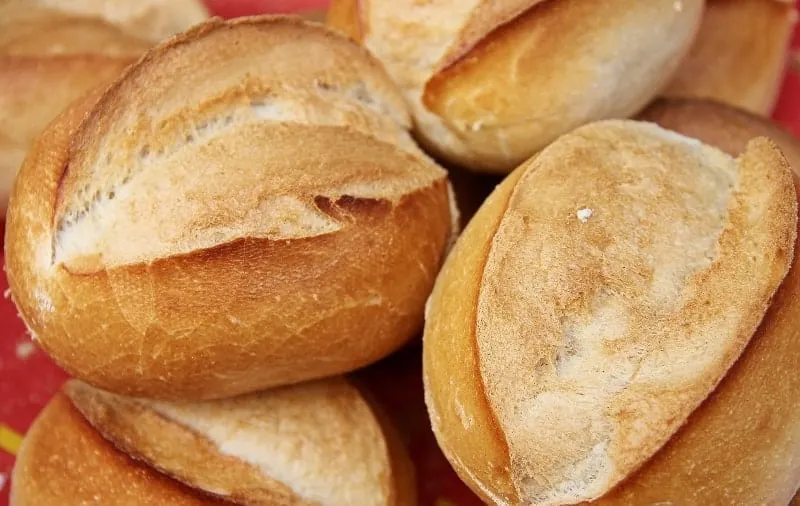Scoring bread is extremely important to be successful during the final part of the bread-making process.
Improperly scoring your bread or not scoring it at all can leave it looking strange and downright ugly.
Although it does take a little skill, it’s by no means a task that’s too difficult. After a few attempts with the right tool, you’ll be able to do it just fine.
Scoring the bread weakens the surface and allows for more expansion, or ‘oven spring’ during baking. Unscored bread can experience something called a ‘blowout’. This means that when expanding, the gas in the bread will find the weakest part of the crust and literally blow out of this point.
Bread with blowout often has a very uneven shape that can leave you shocked and somewhat disappointed when you pull it out of the oven.
This blowout ruins the chances of you getting that aesthetic appearance that so many bakers desire.
Why You Should Be Scoring Your Bread
There are plenty of bread types that can benefit from being scored before baking, so it’s a good idea to know what you’re doing when scoring bread.
There are a few main reasons why you should be scoring your bread.
It’s More Aesthetic
There’s no denying that bread that has lovely slashes in it is much more aesthetic than that of something smooth and plain. Of course, some types of bread look better without being scored, but most basic bread looks significantly better after being scored.
Compare a classic French baguette with a plain store-bought baguette and tell me which one looks (and tastes) better.
You Get More Oven Spring
One thing that every bread baker strives for is a good oven spring. The more the bread can expand in the oven the better, so this is an essential part of the breadmaking process.
The cuts you get after scoring dough allows it to expand significantly more after being put into the oven. When comparing a scored loaf to an unscored loaf, the scored loaf will expand more. The unscored loaf will get to a point where it cannot expand much more without blowing out.
Since you’re cutting into the tight skin of the dough, you’re releasing some surface tension so it can actually rise more.
The Expansion Is Predictable
When you don’t score your dough correctly, you can never know exactly how or where it’s going to expand.
Beginner bakers often find their loaves burst open from the side or bottom due to the dough seam being the weakest part of the loaf.
After scoring your dough properly, you’ll know exactly what area is going to expand and you won’t have to worry about it bursting out of any inconvenient places.
What Happens When You Don’t Score Bread?
You will have probably seen unsuccessful attempts at bread that should have been scored but have instead been left to bake and burst in the oven.
Two main problems can occur when bread isn’t scored – Bursting and limited oven spring.
As I’ve already mentioned, blow out is a big problem but scoring is a very easy solution for it.
Without being scored, the surface of the dough will be tighter and won’t be able to rise as much. This means that you’ll be left with a loaf that’s smaller than it could be.
Blowout is a large problem amongst inexperienced bakers but it has two very simple solutions – Steaming and scoring.
Steam is one of the most important parts of baking bread with excellent oven spring. This is because it turns the exterior of the dough into a gel-like starch layer that can expand easily.
Steam combined with a good score will allow the dough to rise very nicely when baked.
Scoring allows you to control the blowout by creating a weak point in the dough (cutting into it). This weak point then expands and allows for a much nicer and taller loaf of bread.
Both these methods are great for preventing blowout, but let’s talk about scoring.

How To Score Bread Properly
Chances are that you’ll mess up on your first attempt scoring bread, so it’ll take some practice before you figure out how to score properly.
Scoring bread is a skill that a lot of people can struggle with and if you haven’t got the correct scoring tool or technique then you’re much more likely to mess up too.
Although I can’t show you exactly how to score bread myself, I can give a few tips to help you out.
Use The Right Tool
There are plenty of scoring tools you can use for dough, but the most common and effective one to use is a grignette (often called a lame). You’ll see professional bakers and home bakers alike using this tool since it’s so effective.
This tool is just a very sharp razor blade with a handle and it does a great job at scoring if you use it properly.
Be Swift
Scoring slowly will result in the dough sticking to the blade whilst fast scoring will allow for the blade to cut through it easily.
You need to be confident and swift in your scoring or you might be left with an uneven and messy cut.
Score At The Right Angle
Different kinds of scoring techniques require different angles.
For example, if you’re wanting an ear on your sourdough loaf, it’s best to score at a shallow angle.
If you just want the scored area to expand outwards like a baguette, you can just score it at a straighter angle.
Try experimenting with different scoring angles to figure out which way you prefer.
Does All Bread Need To Be Scored?
Although scoring is a big part of making sure bread bakes well and looks great, not all bread needs to be scored.
Most bread that’s put into loaf pans doesn’t need to be scored at all as they should rise just fine. Some people do opt to score the top of them to prevent any possible bursting and to give it a nice pattern on top.
Almost all free-form bread needs to be scored to rise well without bursting in unexpected places. You’ve most likely noticed in bakeries that bread that’s made without a baking vessel is scored.
Now that you know this, it’s time to get your scoring game on. Invest in a grignette, sharp knife, or even just a razor on its own. Experiment with scoring and see what works best for you.
Remember that scoring bread takes practice and you can’t expect to be successful in your first few attempts, so try repeatedly until you get it.

